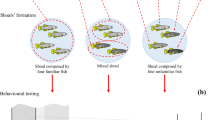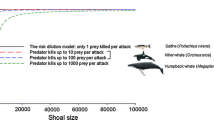Abstract
Shoaling behaviour is commonly displayed by fishes and is thought to reduce predation and increase foraging efficiency. Shoaling relies on coordination between individuals, with higher cohesion and alignment among individuals within a shoal providing greater net benefits of this behaviour. Whilst single species often shoal together in conspecific groups, mixed-species shoaling is frequently observed and has been identified as an important determinant of individual fitness for the multiple species involved. Despite their prevalence, the structure of mixed-species shoals and the mechanisms by which individuals gain protection from predators and enhance their foraging efficiency are not as well understood as for single-species shoals. In fact, mixed-species shoals may be less coordinated than single-species shoals, raising the intriguing question of why fishes form mixed-species shoals when this behaviour could be less beneficial than single-species shoaling. Here we used in situ stereo-video techniques to compare within and between shoal differences in cohesion and alignment, for mixed- and single-species shoals containing the tropical vagrant Indo pacific sergeant major damselfish, Abudefduf vaigiensis, in temperate waters. As expected, mixed-species shoals were less aligned than single-species shoals. However, within mixed-species shoals conspecifics were more cohesive and aligned than were heterospecifics, suggesting coordinated single-species subgroups formed within larger mixed-species shoals. The formation of subgroups may mitigate costs associated with differences between species, therefore enhancing benefits of mixed-species shoaling. As such, multiple levels of social structure may exist within mixed-species shoals that could facilitate growth and survival for vagrant A. vaigiensis in temperate regions. More broadly, this research highlights the importance of considering detailed internal structures of mixed-species shoals when trying to understand cost–benefit trade-offs experienced by individuals.







Similar content being viewed by others
References
Alatorre-Ramirez VG, Galván-Magaña F, Torres-Rojas YE, Olson RJ (2017) Trophic segregation of mixed schools of yellowfin tuna (Thunnus albacares) and skipjack tuna (Katsuwonus pelamis) caught in the eastern tropical Pacific Ocean. Fish Bull 115:252–268. https://doi.org/10.7755/FB.115.2.11
Allan J (1986) The influence of species composition on behaviour in mixed-species cyprinid shoals. J Fish Biol 29:97–106. https://doi.org/10.1111/j.1095-8649.1986.tb05002.x
Axelsen BE, Anker-Nilssen T, Fossum P, Kvamme C, Nøttestad L (2001) Pretty patterns but a simple strategy: predator-prey interactions between juvenile herring and Atlantic puffins observed with multibeam sonar. Can J of Zool 79:1586–1596. https://doi.org/10.1139/z01-113
Barton K (2018) MuMIn: Multi-Model Inference. R Package Version 1(42):1
Beck HJ, Feary DA, Nakamura Y, Booth DJ (2016) Wave-sheltered embayments are recruitment hotspots for tropical fishes on temperate reefs. Mar Ecol Prog Ser 546:197–212. https://doi.org/10.3354/meps11599
Booth DJ, Figueira WF, Gregson MA, Brown L, Beretta G (2007) Occurrence of tropical fishes in temperate southeastern Australia: role of the East Australian current. Estuar Coastal Shelf Sci 72:102–114. https://doi.org/10.1016/j.ecss.2006.10.003
Burgess JW, Shaw E (1981) Effects of Acoustico-Lateralis denervation in a facultative schooling fish: a nearest-neighbor matrix analysis. Behav Neural Biol 33:488–497. https://doi.org/10.1016/S0163-1047(81)91869-0
Camacho-Cervantes M, Garcia CM, Ojanguren AF, Magurran AE (2014) Exotic invaders gain foraging benefits by shoaling with native fish. R Soc Open Sci 1:140101. https://doi.org/10.1098/rsos.140101
Couzin ID, Krause J (2003) Self-organisation and collective behaviour in vertebrates. Adv Study Behav 32:1–75. https://doi.org/10.1016/S0065-3454(03)01001-5
Djurichkovic LD, Donelson JM, Fowler AM, Feary DA, Booth DJ (2019) The effects of water temperture on the juvenile performance of two tropical damselfishes expatriating to temperate reefs. Sci Rep 9:13937. https://doi.org/10.1038/s41598-019-50303-z
Ehrlich PR, Ehrlich AH (1973) Coevolution: heterotypic schooling in Caribbean reef fishes. The Am Nat 107:157–160. https://doi.org/10.1086/282823
Fogarty HE, Burrows MT, Pecl GT, Robinson LM, Poloczanska ES (2017) Are fish outside their usual ranges early indicators of climate-driven range shifts? Glob Chang Biol 23:2047–2057. https://doi.org/10.1111/gcb.13635
Gerlotto F, Bertrand S, Bez N, Gutierrez M (2006) Waves of agitation inside anchovy schools observed with multibeam sonar: a way to transmit information in response to predation. ICES J Mar Sci 63:1405–1417. https://doi.org/10.1016/j.icesjms.2006.04.023
Godin GJ, Morgan MJ (1985) Predator avoidance and school size in a cyprinodontid fish, the banded killifish (Fundulus diaphanus Lesueur). Behav Ecol Sociobiol 16:105–110. https://doi.org/10.1007/BF00295142
Gray J, Denton E (1991) Fast pressure pulses and communication between fish. J Mar Biolog Assoc 71:83–106. https://doi.org/10.1017/S0025315400037413
Herbert-Read JE, Buhl J, Hu F, Ward AJW, Sumpter DJT (2015) Initiation and spread of escape waves within animal groups. R Soc Open Sci 2:140355. https://doi.org/10.1098/rsos.140355
Herbert-Read JE, Rosén E, Szorkovszky A, Ioannou CC, Rogell B, Perna A, Ramnarine IW, Kotrschal A, Kolm N, Krause J, Sumpter DJT (2017) How predation shapes the social interaction rules of shoaling fish. Proc Royal Soc B 284:20171126. https://doi.org/10.1098/rspb.2017.1126
Hobday AJ, Pecl GT (2014) Identification of global marine hotspots: sentinels for change and vanguards for adaptation action. Rev Fish Biol Fish 24:415–425. https://doi.org/10.1007/s11160-013-9326-6
Hunter JR (1969) Communication of velocity changes in jack mackerel (Trachurus symmetricus) schools. Anim Behav 17:507–514. https://doi.org/10.1016/0003-3472(69)90154-7
Ioannou CC, Couzin ID, James R, Croft DP, Krause J (2011) Social organisation and information transfer in schooling fish, In Pitcher TJ, Brown C, Laland K, Krause J (ed) Fish Cognition and Behavior. Blackwell, New Jersey, pp 217–239. https://doi.org/10.1002/9781444342536.ch10
Jolles JW, King AJ, Manica A, Thornton A (2013) Heterogeneous structure in mixed-species corvid flocks in flight. Anim Behav 85:743–750. https://doi.org/10.1016/j.anbehav.2013.01.015
Krause J (1993) The relationship between foraging and shoal position in a mixed shoal of roach (Rutilus rutilus) and chub (Leuciscus cephalus): a field study. Oecologia 93:356–359. https://doi.org/10.1007/BF00317878
Krause J, Butlin RK, Peuhkuri N, Pritchard VL (2000) The social organization of fish shoals: a test of the predictive power of laboratory experiments for the field. Biol Rev 75:477–501. https://doi.org/10.1111/j.1469-185X.2000.tb00052.x
Krause J, Ruxton GD (2002) Living in groups. Oxford University Press, Oxford
Krause J, Ward AJW, Jackson AL, Ruxton GD, James R, Currie S (2005) The influence of differential swimming speeds on composition of multi-species fish shoals. J Fish Biol 67:866–872. https://doi.org/10.1111/j.0022-1112.2005.00768.x
Magurran AE (1990) The adaptive significance of schooling as an anti-predator defence in fish. Ann Zool Fenn 27:51–66
Magurran AE, Higham A (1988) Information transfer across fish shoals under predator threat. Ethology 78:153–158. https://doi.org/10.1111/j.1439-0310.1988.tb00226.x
Magurran AE, Pitcher TJ (1987) Provenance, shoal size and the sociobiology of predator-evasion behaviour in minnow shoals. Proc Royal Soc B 229:439–465. https://doi.org/10.1098/rspb.1987.0004
Makris NC, Ratilal P, Symonds DT, Jagannathan S, Lee S, Nero RW (2006) Fish population and behavior revealed by instantaneous continental shelf-scale imaging. Science 311:660–663. https://doi.org/10.1126/science.1121756
MacGregor HEA, Herbert-Read JE, Ioannou CC (2020) Information can explain the dynamics of group order in animal collective behaviour. Nat Commun 11:2737. https://doi.org/10.1038/s41467-020-16578-x
Paijmans KC, Booth DJ, Wong MYL (2019) Towards an ultimate explanation for mixed-species shoaling. Fish Fish 20:921–933. https://doi.org/10.1111/faf.12384
Paijmans K (2020) Data - predation avoidance and foraging efficiency contribute to mixed-species shoaling by tropical and temperate fishes.xlsx. Figshare. 10.6084/m9.figshare.12032763.v1
Paijmans KC, Booth DJ, Wong MYL (2020) Predation avoidance and foraging efficiency contribute to mixed-species shoaling by tropical and temperate fishes. J Fish Biol 96:806–814. https://doi.org/10.1111/jfb.14277
Paijmans KC, Booth DJ, Wong MYL (2021) Odd one in: oddity within mixed-species shoals does not affect shoal preference by vagrant tropical damselfish in the presence or absence of a predator. Ethology 127:125–134. https://doi.org/10.1111/eth.13110
Parrish JK (1989) Layering with depth in a heterospecific fish aggregation. Environ Biol Fishes 26:79–85. https://doi.org/10.1007/BF00001024
Parrish JK (1999) Using behavior and ecology to exploit schooling fishes. Environ Biol Fishes 55:157–181. https://doi.org/10.1023/A:1007472602017
Partridge BL (1980) The effect of school size on the structure and dynamics of minnow schools. Anim Behav 28:68–77. https://doi.org/10.1016/S0003-3472(80)80009-1
Partridge BL, Pitcher T, Cullen JM, Wilson J (1980) The three-dimensional structure of fish schools. Behav Ecol Sociobiol 6:277–288. https://doi.org/10.1007/BF00292770
Partridge BL, Pitcher TJ (1980) The sensory basis of fish schools: relative roles of lateral line and vision. J Comp Physiol 135:315–325. https://doi.org/10.1007/BF00657647
Pinheiro J, Bates D, DebRoy S, Sarkar D, R Core Team (2016) nlme: linear and nonlinear mixed effects models_. R package version 3.1–128. <URL:http://CRAN.Rproject.org/package=nlme>
Pitcher TJ (1983) Heuristic definitions of fish shoaling behaviour. Anim Behav 31:611–613. https://doi.org/10.1016/S0003-3472(83)80087-6
Pitcher TJ (1993) Functions of shoaling behaviour in teleosts. In: Pitcher TJ (ed) The behaviour of teleost fishes. Springer, Berlin, pp 294–337
Pitcher TJ, Partridge BL, Wardle C (1976) A blind fish can school. Science 194:963–965. https://doi.org/10.1126/science.982056
Pitcher TJ, Wyche CJ (1983) Predator-avoidance behaviours of sand-eel schools: why schools seldom split. In: Oakes GLD, Lindquist GD, Helfman SG, Ward AJ (eds) Predators and prey in fishes. Springer, Berlin, pp 193–204
Pulliam HR (1973) On the advantages of flocking. J Theor Biol 38:419–422. https://doi.org/10.1016/0022-5193(73)90184-7
Radakov DV (1973) Schooling in the Ecology of Fish. John Wiley & Sons, New Jersey
R Core Team (2021) R: A language and environment for statistical computing. R Foundation for Statistical Computing Vienna, Austria. URL https://www.R-project.org/
Reebs SG (2000) Can a minority of informed leaders determine the foraging movements of a fish shoal? Anim Behav 59:403–409. https://doi.org/10.1006/anbe.1999.1314
Rieucau G, Fernö A, Ioannou CC, Handegard NO (2015) Towards of a firmer explanation of large shoal formation, maintenance and collective reactions in marine fish. Rev Fish Biol and Fish 25:21–37. https://doi.org/10.1007/s11160-014-9367-5
Rosenthal SB, Twomey CR, Hartnett AT, Wu HS, Couzin ID (2015) Revealing the hidden networks of interaction in mobile animal groups allows prediction of complex behavioral contagion. Proc Natl Acad Sci USA 112:4690–4695. https://doi.org/10.1073/pnas.1420068112
Ryer CH, Olla BL (1992) Social mechanisms facilitating exploitation of spatially variable ephemeral food patches in a pelagic marine fish. Anim Behav 44:69–74. https://doi.org/10.1016/S0003-3472(05)80756-0
Shelton DS, Price BC, Ocasio KM, Martins EP (2015) Density and group size influence shoal cohesion, but not coordination in zebrafish (Danio rerio). J Comp Psychol 129:72–77. https://doi.org/10.1037/a0038382
Smith SM, Fox RJ, Booth DJ, Donelson JM (2018) Stick with your own kind, or hang with the locals? Implications of shoaling strategy for tropical reef fish on a range-expansion frontline. Glob Change Biol 24:1663–1672. https://doi.org/10.1111/gcb.14016
Sorte CJB, Williams SL, Carlton JT (2010) Marine range shifts and species introductions: comparative spread rates and community impacts. Glob Ecol Biogeogr 19:303–316. https://doi.org/10.1111/j.1466-8238.2009.00519.x
Sumpter D, Buhl J, Biro D, Couzin I (2008) Information transfer in moving animal groups. Theory Biosci 127:177–186. https://doi.org/10.1007/s12064-008-0040-1
Sunday JM, Pecl GT, Frusher S, Hobday AJ, Hill N, Holbrook NJ, Edgar GJ, Stuart-Smith R, Barrett N, Wernberg T (2015) Species traits and climate velocity explain geographic range shifts in an ocean-warming hotspot. Ecol Lett 18:944–953. https://doi.org/10.1111/ele.12474
Vabø R, Nøttestad L (1997) An individual based model of fish school reactions: predicting antipredator behaviour as observed in nature. Fish Oceanogr 6:155–171. https://doi.org/10.1046/j.1365-2419.1997.00037.x
Ward A, Webster M (2016) Sociality: the behaviour of group-living animals. Switzerland: Springer International Publishing.
Ward AJW, Herbert-Read JE, Sumpter DJT, Krause J (2011) Fast and accurate decisions through collective vigilance in fish shoals. Proc Natl Acad Sci USA 108:2312–2315. https://doi.org/10.1073/pnas.1007102108
Ward AJW, Schaerf TM, Burns ALJ, Lizier JT, Crosato E, Prokopenko M, Webster MM (2018) Cohesion, order and information flow in the collective motion of mixed-species shoals. R Soc Open Sci 5. https://doi.org/10.1098/rsos.181132
Acknowledgements
Thank you to James Segar for assistance with video analysis and for writing customised code for the quantification of shoaling metrics using EventMeasure©. Thank you to field work volunteers Abbey Dalton, Doug Reeves, Alex Pike and Shona Rankin. Thank you for funding support from the Holsworth wildlife research endowment and Australian government research training programme.
Author information
Authors and Affiliations
Corresponding author
Ethics declarations
Ethics approval
This work was conducted in accordance with the University of Wollongong’s Animal Ethics Committee approval (No. AE 16/17) and under Booderee National Park research permit (No. BDR17/00001).
Conflict of interest
The authors declare no competing interests.
Additional information
Publisher's note
Springer Nature remains neutral with regard to jurisdictional claims in published maps and institutional affiliations.
Supplementary Information
Below is the link to the electronic supplementary material.
Rights and permissions
About this article
Cite this article
Paijmans, K.C., Booth, D.J. & Wong, M.Y. Single-species subgroups form within mixed-species shoals of tropical and temperate fishes. Environ Biol Fish 105, 1975–1988 (2022). https://doi.org/10.1007/s10641-021-01188-3
Received:
Accepted:
Published:
Issue Date:
DOI: https://doi.org/10.1007/s10641-021-01188-3




